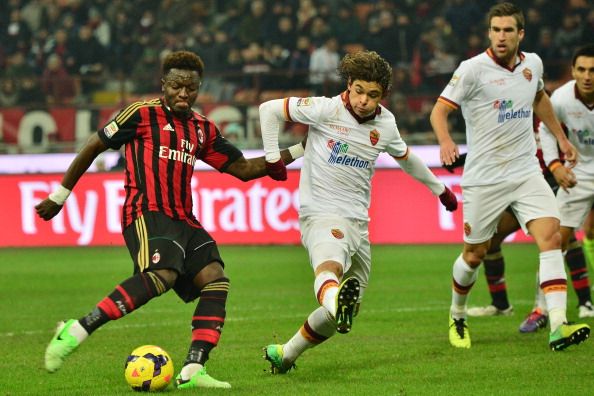
AC Milan 2-2 AS Roma: Tactical Analysis - Defensive and positional errors prove costly for both teams
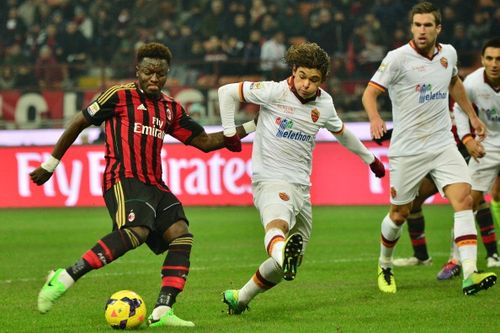
AC Milan have had a poor first half of the campaign and find themselves struggling to get into the coveted European spots. Roma, on the other hand, had a dream start to the season which saw them winning 10 consecutive games having conceded just 1 goal, before hitting a slight slump; they’ve won just 1 game in their last 5 Serie A matches, and are still unbeaten.
AC Milan needed to start getting points to keep pace with those above them, or risk falling into mid-table obscurity. AS Roma needed points for a whole different reason, to ensure Juventus (who won 4-0 on the weekend) don’t runaway with the title again.
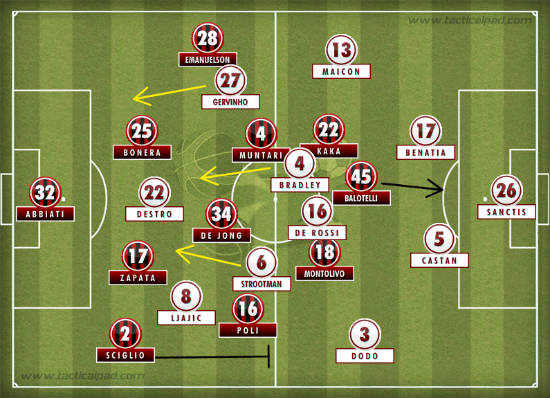
Milan: Abbiati (Gabriel 45?); De Sciglio, Bonera, Zapata, Emanuelson (Zaccardo 89?); Muntari, De Jong, Poli (Matri 66?); Montolivo, Kaka; Balotelli
Roma: De Sanctis; Maicon, Benatia, Castan (Burdisso 45?), Dodò; De Rossi, Strootman, Bradley; Ljajic (Florenzi 81?), Destro (Totti 64?), Gervinho
Milan lack tactical and positional discipline
Massimo Allegri has come under a lot of pressure this season for the poor results, especially domestically. Milan’s head coach has failed to give his side a clear tactical identity, and this was evident against Roma. They lacked the basic tactical and positional discipline which has contributed largely for the sides failure to earn positive results.
Roma’s midfield trio are a hardworking bunch. They lack the extra creative edge, but given space, they can take advantage, playing short passes between each other and taking the ball into an attacking zone. Roma found it easy to gain tactical superiority over the home side.
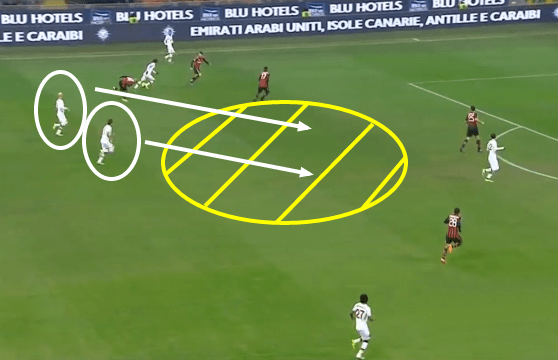
As seen above here, when Roma shifted the ball into wide areas, it automatically pulled the closest defenders onto the man in possession; added to that, the midfielders that should be covering the central area (especially since Roma’s midfielders are offering an option there with their runs), are also pulled out wide creating holes in dangerous areas.
It was this lack of tactical and positional intelligence that created Roma’s first goal as well. Allowing players to make free runs into the box and leaving the sole striker unmarked as well is pure suicide. It’s no wonder that Milan have struggled this season, despite the 2-2 draw, there were more negatives than positives from the Roma game.
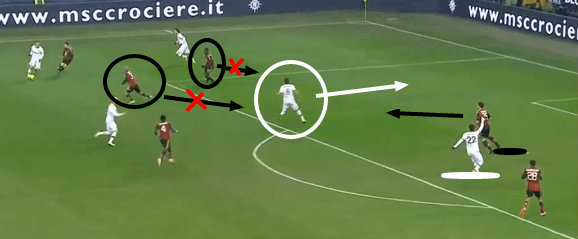
As seen here above, De Jong and Zapata are attracted to Ljajic (in possession) in addition to De Sciglio who has already left his position in a bid to track the Roma player. De Jong and Zapata’s poor tactical intelligence has created a huge gap in the box, which Strootman runs into, forcing Bonera to come across and cover the area leaving Destro in acres of space. In this way, Roma were able to use Milan’s poor tactical showing in the defensive area to create the first goal.
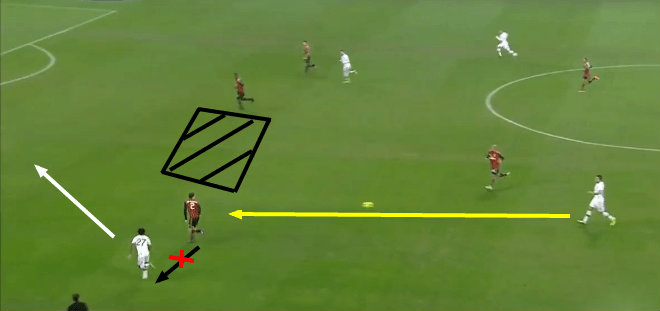
Again for Roma’s second goal (as seen above), they found their way in behind the defence with complete ease. A simple through ball, played through acres of space, allowed Gervinho to use his pace to get into the box. Di Sciglio was left, ball watching (?), failing to track the run of the Ivorian. This gap was created as Emmanuelson had wandered forward, Bonera moved left to cover the area, prompting Zapata to follow suit, leaving the big gap through the middle.
It’s hard to place complete blame on Di Sciglio, either decision could have been detrimental. At the end of it, it seemed like the youngster was confused, tactically, allowing Gervinho in.
It must be said here that Milan’s first goal too arised out of a poor defensive error on Roma’s part. Zapata was left completely unmarked to collect the knockdown and score from close range.
Pressing Milan into errors
Pressing of the opposition while not in possession has become a basic characteristic of Rudi Garcia’s side. Led by their hardworking midfield, Roma’s wide men and lone striker are always seen closing down the opposition in a bid to regain possession. They’ve been excellent in preventing the opponents time and space to create anything meaningful.
Allegri’s men play a slow approach, willing to keep the ball in defense and allow the attackers to make forward runs; the safest way to create something and ensure ball retention. But when faced against a side like Roma that press from the front, half of Milan’s possession based play is lost. It meant that Milan were forced into playing long balls over the top onto their attacking players.
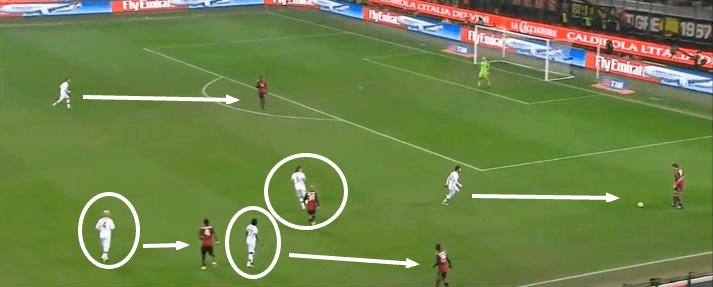
The illustration above portrays Roma’s high pressing approach, with the players attacking both the player in possession and his passing option. Five Milan men in the defensive zone are tracked by five Roma players. Milan couldn’t afford to pass the ball out or dribble it to safety, long balls were the only option.
This pressing game was seen all across the pitch, even in the centre of the park. There was absolutely no space given to Milan to play their football, gaps were instantly closed and Milan’s man in possession was constantly tracked.

Balotelli, in this illustration, has dropped to midfield to receive the ball, as soon as the ball has found his feet, Roma players crowd around him and prevent him from playing with the ball. It also meant that other Milan midfielders were left free, but Roma were able to cover effectively close down and cover the players in possession.
De Sciglio’s defensive shift
As the game wore on, Milan’s defensive play improved, but rather than being solid, it seemed more desperate. Either way, it proved to be effective as Roma, despite being offered space in midfield, failed to create much further upfield.
As seen in the first example, Milan left the central areas unmanned, but moved quickly to close down the wide areas. A lot of Roma’s game, in attacking areas, arised from the left flank as they looked to make full use of Ljajic’s form. The left flank was a popular attacking avenue and Roma saw a lot of the ball in this region.
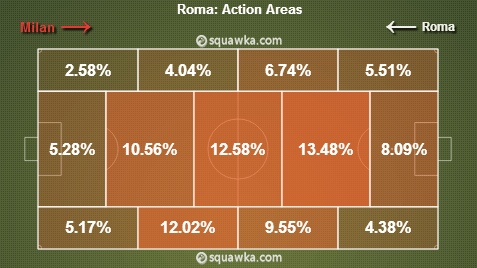
As seen in the illustration above, the ball was often in Roma’s midfield (mainly in deeper areas) as the trio looked to recycle the ball with the hopes of creating opportunities, but more importantly ensuring retention of the ball. The left flank, played primarily by Ljajic, was a popular area as well. Unfortunately for the capital club, Milan were adept at nullifying the threat, and De Sciglio must be given credit for this.
The youngster, though negligible in an attacking sense, was solid at defending for the side. 6 tackles, and 6 interceptions on Roma’s left flank was extremely effective in a defensive sense.

It meant that despite having possession in the wide areas, Roma failed to create anything meaningful. The first goal was scored as a result of a throughball from this area, but then on Roma failed to make Milan play. Roma attempted 8 crosses (including corners) from this flank, with only one finding a team-mate, the rest were wasted opportunities.
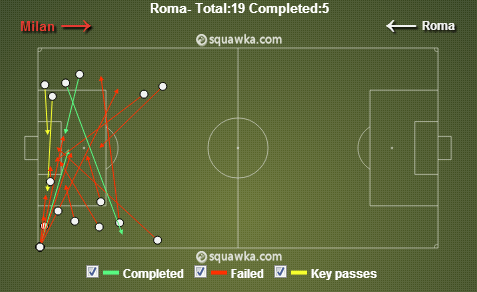
Where does this leave them?
The draw, although a fair result, didn’t do any good to either side. It has left AC Milan 9 points behind the final Europa League spot, but interestingly (and worryingly) they are now just 6 points above the relegation zone.
Roma, despite their incredible start, now find themselves 5 points behind defending champions Juventus, and a run of 5 draws in their last 6 games.